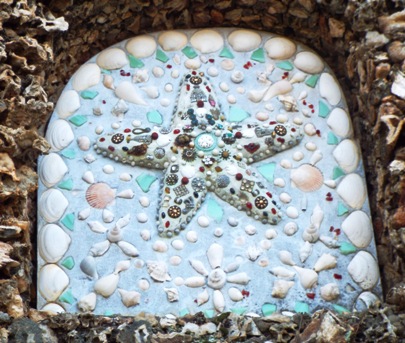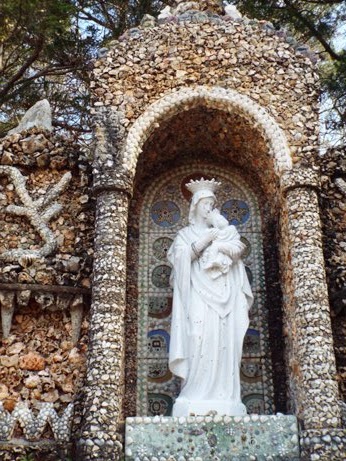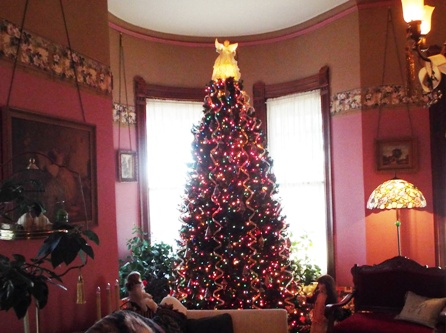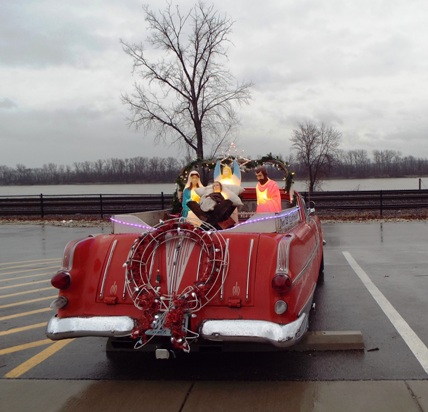Tucked
back in the quiet La Barque Creek valley in rural Jefferson County, Missouri, is a shrine...a
shrine dedicated to Our Lady of Czestochowa and, at the same time, a memorial
to the life-long work of one Franciscan missionary. The Black Madonna Shrine and Grottos is an
example of what one man with faith and artistic vision can create.
 |
| Our Lady of Czestochowa, the Black Madonna |
 |
| Sign at the entrance to the Black Madonna Shrine |
The
history of Our Lady of Czestochowa (chen-sta-ho'-va) goes back 2,000 years. Legend has it that St. Luke, one of the four
writers of the Gospel, painted a picture of the Virgin Mary on the top of a
cypress wood table owned by the Holy Family.
It was venerated for centuries and was later associated with Constantine
the Great, the first Christian Emperor of Rome.
Eventually, it was brought to Kiev, Russia, where it remained for 579
years. In 1382, for safekeeping, the painting was entrusted to the Basilian
Monks of the Greek Rite near the village of Czestochowa. A few years later, it was given to the Latin
Rite Hermits of St. Paul, who are still in Czestochowa today. The painting has a tumultuous history
associated with warring rulers and countries as well as miraculous events.
St. Luke
painted Mary with olive skin, which is in keeping with her Middle Eastern
heritage. (It was not until the Renaissance, centuries
later, that the Blessed Virgin was portrayed with fair skin and blue eyes.) A fire destroyed the chapel in Constantinople where the portrait once hung. Miraculously, the painting and a small section of the wall on which it hung were spared, but the soot and intense heat further darkened the faces of Mary and Jesus, and the painting became popularly known as
the Black Madonna.
 |
This copy of the portrait of the Black Madonna was commissioned
to replace the one that was destroyed in the chapel fire. It arrived
only weeks before Brother Bronislaus' death. Another copy of the
painting can be found in the Pope's private chapel in the Vatican |
In 1927, Cardinal
Glennon, the Archbishop of St. Louis, invited a group of Franciscan Missionary Brothers to
emigrate from Poland to establish a nursing home for men. One of the Brothers who came to this rural
area near Eureka was Brother Bronislaus Luszcz, OSF.
 |
| Brother Bronislaus Luszcz, OSF |
As a young
man in Poland, Bronislaus witnessed many pilgrims pass through his village to
visit the monastery in the town of Czestochowa to pay homage to Our Lady of
Czestochowa, the Black Madonna. Brother
Bronislous was touched by the faithfulness of these people and wished to share
their faith and devotion with others in his adopted land. While most of the Brothers cared for the men in the nursing home, Brother Bronislaus was assigned the job of caring for the grounds...landscaping, planting flowers and shrubs. He went a step further and created a grotto - or rather a series of grottos
- in honor of the Virgin Mary, Our Lady of Czestochowa, the Black Madonna. The grottos were a labor of love and faith
created with no assistance from others and without the use of power tools. The
Black Madonna Shrine and Grottos are the tangible expression of one man's faith
and devotion.
Brother
Bronislaus began his work in 1937 by clearing a section of woods, building a
beautiful cedar chapel and placing a painting of Our Lady above the altar. He then began working on the grottos
themselves. The first grotto that
Brother Bronislaus built is known as Our
Lady of Sorrows Grotto. A
perfectionist, Brother Bronislaus worked on this grotto for years, tearing it
down and rebuilding it several times.
 |
The Our Lady of Sorrows Grotto, the first one that Brother Bronislaus built.
He tore it down and rebuilt it several times. A "grotto" is defined as "a
cave or an artificial recess or structure made to resemble a natural cave" |
 |
The original cedar chapel that Brother Bronislaus built.
It was destroyed in 1958 by a fire set by an arsonist. |
 |
These are the final bells ever struck by the Stuckstede Bell Foundry of St. Louis.
They are sitting on the foundation of the original bell tower from the wooden
chapel. The bell tower survived the fire, but was later demolished due to decay. |
 |
In the mid-1960's, an outdoor, covered chapel was built to replace the
burned wooden chapel. The mosaic wall behind the altar was created
by Frederic Henze in memory of his friend, Brother Bronislaus. |
 |
| Close-up of the altar and portrait of the Black Madonna. |
Brother
Bronislaus used discarded bits and pieces in his creations. He ingeniously
crafted flowers and flower pots from electrical fixtures that had been tossed
aside. He utilized costume jewelry and sea shells that were donated. He saw
beauty and usefulness where others saw only refuse to be thrown out. Flowers were also made by pouring concrete in
cupcake pans. Jello molds became
flower pots.
 |
The green-tinted foot of this flower pot is an
up-side-down Jello mold. The flowers themselves
are made of concrete poured into cupcake pans |
 |
Bits of costume jewelry, buttons, and sea shells are used to
decorate the grottos |
 |
Bits of colored glass set into the recesses behind intricately
hand-made decorative stone scrollwork provides
illumination when the sun shines on the grottos |
 |
Brother Bronislaus created 3-D effects in many of the grottos. The stone is native Missouri
Tiff rock (geological name Barite) mined at Potosi, some 30 miles south of the site |
 |
Costume jewelry, religious medals, and buttons, or whatever else
he could find, all became part of Brother Bronislaus' materials |
Brother
Bronislaus continued working on the grottos until the day he died. On August 12, 1960, already weakened from a
bout of Asian Flu, he was overcome by the summer heat. Members of his order knew something was wrong
when he failed to return for evening prayers.
A search ensued, and his body was discovered in front of the Our Lady of
Perpetual Help Grotto.
 |
Grotto of Our Lady of Perpetual Help, where Brother Bronislaus
died on August 12, 1960. |
 |
These intricately hand-made kneelers, where visitors can
pause to pray, are located in front of several of the grottos |
 |
| The Assumption Grotto |
 |
| The Garden of Gethsemane Grotto, with the Crucifixion Overlook on the ridge above it |
 |
| The Nativity Grotto,the only "natural" grotto, or cave, on the site |
 |
| The St. Francis Grotto, in honor of the founder of the Franciscan Order, St. Francis of Assisi |
 |
| These rabbits on the St. Francis Grotto were made from concrete poured into cake molds |
 |
| The St. Joseph Grotto. Note, again, the intricate stone scroll work. |
 |
| A bridge on the path as you enter the area of the grottos, with hand-made stone railings |
 |
A plaque in recognition of Charles Bendel, the sculptor
who created the statues used in the grottos |
 |
Constructed over a 10-year period, the Life Memorial is a tribute to LIFE.
The cross is the original one made by Brother Bronislaus for the Crucifixion
Overlook. The stones at the base are from the original monastery
that the Brothers lived in when they arrived in Eureka in 1927. |
 |
Cornerstone from the original monastery building. When the Brothers arrived in 1927
they rebuilt and moved into an old abandoned Sisters of Mercy convent on the.
property that had apparently been built, according to its cornerstone, in the 1880's. |
 |
One of the Stations of the Cross, and a portion of the wall that
defined the original grotto area. On that path, you can just
see the railings of the bridge shown in a previous photo. |
 |
In the late 1960's, a drunk driver lost control of his car and
hit the wall, destroying a portion of it. It was never rebuilt. |
The Black
Madonna Shrine is part of a 200 hundred acre Franciscan Mission. The Saint
Joseph's Hill Infirmary closed in 2008. The Infirmary, the monastery, and out
buildings are not open to the public. The
grounds and buildings are used for retreats for religious orders from not only
the St. Louis area, but around the country.
Mass is offered most Sundays at Sacred Heart Chapel.
 |
The St. Joseph's Hill Infirmary building, now closed. Mike's uncle, John,
was a patient here at the time of his death in 1985. |
 |
The rooms with lots of windows for natural lighting in the pentagon-shaped section
at the end of the building were day rooms or lounges for the patients on each floor. |
 |
Cornerstone of St. Joseph's Hill Infirmary. The building does not
look 70 years old. We wonder if this cornerstone was from an
older building that was replaced by this one? |
 |
| Residential buildings of Our Lady of Angels Monastery behind the Infirmary building. |
 |
This is the only remaining original building that was on the property when the
Franciscan Missionary Brothers arrived in 1927. It probably dates back to the 1880's |
The Black
Madonna Grotto receives no financial support from any parish or diocese. Its
upkeep is dependent on contributions made by visitors and friends.
The Black
Madonna Shrine and Grottos is open daily...phone (636) 938-5361 to verify
operating hours. The address is 100 St.
Joseph Hill Road, Pacific, MO 63069. For
more information, visit this web site
 |
| An overview of several of the grottos. |
 |
| Another view of several more grottos |
On a trip
to Wisconsin to visit her cousin several years ago, Yvonne stopped to visit the
Holy Ghost Grotto in Dickeyville, WI,
constructed between 1925 and 1931 by Father Mathias Wernerus. Then, not quite two years ago, while
traveling through Alabama, we happened upon the Ave Maria Grotto in the town of Cullman, the life-long work of
Brother Joseph Zoettl. We wrote about
our visit to the Ave Maria Grotto in
a blog entitled Ora et Labora in May
of 2014.
 |
This statue of a boy holding his dog on his lap
was one of Brother Bronislaus' favorites. |
In a small town half-way between Huntsville and Birmingham or in a remote valley in northwest Jefferson County, you can never tell where you will find your Road Stories.
Prayer of St. Francis of Assisi,
founder of the Franciscan Order
Lord, make me an instrument of Your peace.
Where there is hatred, let me sow love;
where there is injury, pardon;
where there is doubt, faith;
where there is despair, hope;
where there is darkness, light;
where there is sadness, joy.
O, Divine Master, grant that I may not so much
seek
to be consoled as to console;
to be understood as to understand;
to be loved as to love.
For it is in giving that we receive;
it is in pardoning that we are pardoned;
it is in dying that we are born again to eternal life.













































































